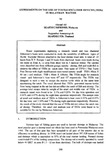| dc.contributor.author | Ali, Ahmad | |
| dc.contributor.author | Ananpongsuk, Supachai | |
| dc.date.accessioned | 2018-12-05T08:59:23Z | |
| dc.date.available | 2018-12-05T08:59:23Z | |
| dc.date.issued | 1997 | |
| dc.identifier.citation | Ali, A., & Ananpongsuk, S. (1997). Experiments on the use of turtle excluder devices (TEDs) in Malaysian waters. In Proceeding of the Regional Workshop on Responsible Fishing, Bangkok, Thailand, 24-27 June 1997 (pp. 298-307). Samut Prakarn, Thailand: Training Department, Southeast Asian Fisheries Development Center. | en |
| dc.identifier.uri | http://hdl.handle.net/20.500.12067/761 | |
| dc.description.abstract | Trawl experiments deploying a research vessel and two chartered fishermen s boats were conducted to study the suitability of different types of Turtle Excluder Devices attached to the local shrimp trawl nets. A total of 23 hauls from R.V. Kerapu 1 and 24 hauls from chartered boats were made during the study in Zone A, i.e area from shore line to 5 nautical miles). The catches were classified into three different groups namely: shrimp, fish and trash fish to observe the effect of TEDs on catch rates. Two types of TTFD (Thai Turtle Free Device with slight modification) were tested namely: small TED (80cm X 80 cm) and medium TED (80cm X 100cm). The TEDs angle for research vessel and fishermen s boat were 45° and 55° respectively. The TEDs was designed in such a way to escape the marine turtle while at the same time maintaining the catch. The result showed that, TEDs prevented marine turtles from being trapped in the net but did not effect the catch of fish and shrimp. The average total escape rates by weight of the small and middle size of TEDs in research vessel were found to be 2.3% and 5.25% for day time operation and 0.01% and 4.67% during the night time operation respectively. The escape rates of small and medium size of TEDs in fishermen s boat were 6.53% and 4.05% for day time and 3.34% and 7.7% during night operation respectively. However, the result of the study showed that the use of TEDs did not reduce the catch rate of shrimp. Therefore the small and medium size of TEDs were found to be suitable for the use by Malaysian fishermen. | en |
| dc.language.iso | en | en |
| dc.publisher | Training Department, Southeast Asian Fisheries Development Center | en |
| dc.subject | Malaysia | en |
| dc.title | Experiments on the Use of Turtle Excluder Devices (TEDs) in Malaysian Waters | en |
| dc.type | Conference paper | en |
| dc.citation.spage | 298 | |
| dc.citation.epage | 307 | |
| dc.subject.asfa | sustainable fishing | en |
| dc.subject.asfa | sustainability | en |
| dc.subject.asfa | marine fisheries | en |
| dc.subject.asfa | Turtle entanglement | en |
| dc.subject.asfa | Turtle excluder devices | en |
| dc.subject.asfa | By-catch excluder devices | en |
| dc.subject.asfa | Sea turtles | en |
| dc.subject.asfa | trawling | en |
| dc.subject.asfa | trawl nets | en |
| dc.subject.asfa | Gear selectivity | en |
| dc.subject.asfa | shrimp fisheries | en |
| dc.subject.asfa | Trash fish | en |
| dc.citation.conferenceTitle | Proceedings of the Regional Workshop on Responsible Fishing, Bangkok, Thailand, 24-27 June 1997 | en |

